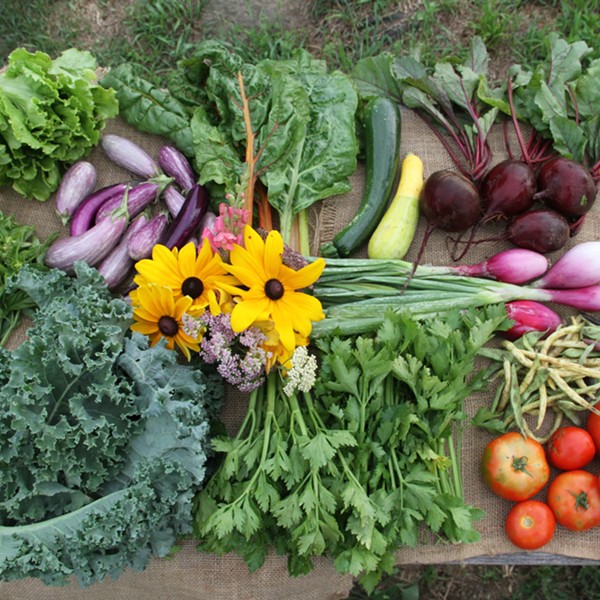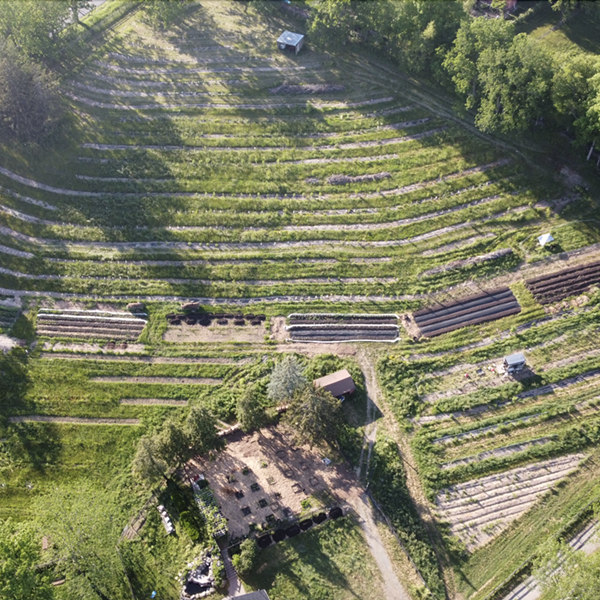Farms and restaurants would seem to be logical partners but, sometime in the mid-20th century, the two entities were pushed far apart by the lengthening chain of food distribution. In 2004, a small group of upper Hudson Valley farmers and New York City chefs launched a unique kind of service that is repairing the chasm that separates their businesses.
The service, Farm to Chef, Inc., has been functioning weekly without a break for more than three years, ferrying meats, eggs, cheeses, fruits, vegetables, and maple products from member farms in Rensselaer, Washington, and Saratoga counties—and beyond—to participating New York City restaurants. Every Tuesday, participating farmers bring their products to a central site in Washington County, about 30 miles north of Albany; there they are sorted by restaurant for Wednesday delivery.
The for-profit Farm to Chef was established to facilitate direct trade between producer and user, as well as to promote the burgeoning local-foods movement. The enterprise was conceived by two unlikely farmers, a young professional couple named Mike Yezzi and Jen Small. In September 2001, Yezzi and Small set up a vendor booth at the world-famous Union Square Greenmarket in Manhattan. This was the first time they had driven the more than 150 miles to sell pork from their Flying Pigs Farm, a nascent operation in Shushan, New York, between Saratoga Springs and the Vermont border.
A few years earlier, the couple had scraped together the funds to purchase the 150-acre hill farm, located next to Small’s family property, when it was threatened with development. They knew they would have to find a way to make the farm pay for itself—and the fixer-upper house that came along with it. In 2000, the former Manhattanites bought three piglets as an experiment in leading an agricultural life.
Chefs looking for fresh and unique foods direct from regional farms have long been regulars at Union Square, the flagship site of the New York City Greenmarkets. So it was not surprising that chef Mary Cleaver, an early proponent of sustainable cuisine and a successful restaurateur and caterer, found the Flying Pigs farmers on the day of their first appearance. Cleaver, now a Farm to Chef board member, says that then it was unusual to see meats at that market. At the same time, Small and Yezzi also became acquainted with another influential supporter of local foods, Savoy chef-owner Peter Hoffman.
Both chefs encouraged the new farmers and tutored them on the restaurant industry’s needs and customs so they could become effective marketers. Just as they were eager for Flying Pigs’ distinctive heritage breed pork, so unlike the widely available factory-farmed variety, the chefs also wanted access to other interesting foods upstate farmers could provide. The couple returned and talked up New York’s opportunities to neighboring farmers, but few could or desired to regularly make the exhausting journey south.
This was just on the eve of the explosion in consciousness about “food miles” and the “locavore” movement, which encourages consumers to “eat locally” for health and environmental reasons. Decades before, the movement had been founded by pioneers with a passion for seasonal foods from family farms. Chef Alice Waters, at Chez Panisse in Berkeley, helped put this common-sense concept on the map as far back as the 1970s.
By the late ’90s, local-food campaigns were emerging on behalf of regional farms. To benefit both agriculture and tourism throughout the Green Mountain state, the Vermont Fresh Network began to hook up chefs and farmers and promote participating restaurants. Such initiatives have spread regionally: Now there’s Berkshire Grown in western Massachusetts, and in New York, Columbia County’s Bounty of the County, Adirondack Harvest, and the Slow Food Hudson Valley Convivium.
But putting “local” into practice is all about distribution. “Because there isn’t adequate distribution for small farmers, New York City restaurants buy apples from Washington state, peaches from Georgia, and beef from Nebraska or Kansas instead of foods produced three hours up the road,” Yezzi observes.
Taking on the challenge, Yezzi and Small developed the concept of Farm to Chef, and put together a grant application with input from others. The Farm to Chef Express, as it was originally called, aimed to address Flying Pigs’ distribution issues while creating a mechanism that would enable fellow farmers to gain a better price for their products, and move greater volumes. New York restaurants were attractive as a bigger and better-paying market at first, where the allure of local foods was catching on faster. Part of the vision, according to Yezzi, is to capture some of the wealth that Manhattan restaurants attract from all over the world, “to help preserve upstate farms.”
















